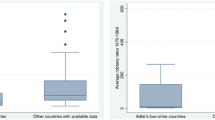Abstract
This article examines theimpact of globalization on both crime and crimecontrol at the national and global levels. Tomake conceptual sense out of the transformingnature of these activities at the turn of the21st century, a threefold analysis ispresented: (1) an overview of the threetraditional developmental models of crime andcrime control – modernization, world system,and opportunity; (2) a characterization ofcrime and crime control in relationship to themore recently emerging models of globalization;and (3) a discussion of the implications of thedialectical relations between the models ofdevelopment and the models of globalization.Assessments of the models and other provisionalconclusions are drawn based on a survey of bothcrime and crime control in 15 developed,developing, and post-traditional nation-states.
Similar content being viewed by others
References
Barak, G. (1990). Crime, criminology, and human rights: Toward an understanding of state criminality. Journal of Human Justice 2(1), 3–14.
Barak, G. (1998). Integrating Criminologies. Boston: Allyn and Bacon.
Barak, G. (2000). Crime and Crime Control: A Global View. Westport, CN: Greenwood Press.
Bradsher, K. (1999). For car thieves, a technological arms race. New York Times (March 21), F1.
Cohen, L. andFelson, M. (1979). Social change and crime rate trends: A routine activities approach. American Sociological Review 44, 588–608.
Durkheim, E. (1964). The Division of Labor in Society. New York: Free Press.
Early, S. (1998). Slicing the globaloney: A review of workers in a lean world: unions in the international economy. The Nation (February 16), 33–35.
Elias, N. (1982). The Civilizing Process, II: State Formation and Civilization. Oxford: Oxford University Press.
Friday, P. (1996). The need to integrate comparative and international criminal justice into a traditional curriculum. Journal of Criminal Justice Education 7, 227–239.
Guttenplan, D.D. (1999). Letter fromLondon: Tony Blair quite likes the euro, butmany britons think it's a foreign plot. ” The Nation (January 11/19), 18–24.
Hazlehurst, K. andHazlehurst, C. (1998). Gangs and Youth Subcultures: International Explorations. New Brunswick, USA: Transaction Publishers.
Hirst, P. andThompson, G. (1996). Globalization in Question: The International Economy and the Possibilities of Governance. Cambridge: Polity Press.
Hufstedler, S.M. (1980). World in transition. Change (May/June), 8–9.
Humphries, D. andGreenberg, D. (1981). The dialectics of crime control. In D. Greenberg (ed.), Crime and Capitalism. Palo Alto: Mayfield, pp. 209–254.
Jamieson, R.,South, N., andTaylor, I. (1997). Economic Liberalisation and Cross-Border Crime: The North American Free Trade Area and Canada's Border with the US. Salford Papers in Sociology, No. 22: The University of Salford, UK.
Moore, R.H. andFields, C.B. (1996). Comparative criminal justice: Why study? In C. Fields andR. Moore (eds.), Comparative Criminal Justice: Traditional and Nontraditional Systems of Law and Control. Prospects Heights, IL: Waveland Press, pp. 1–14.
Neapolitan, J.L. (1997). Cross-National Crime: A Research Review and Sourcebook. Westport, CN: Greenwood Press.
Neuman, W.L. andBerger, R.J. (1988). Competing perspectives on cross-national crime: An evaluation of theory and evidence. The Sociological Quarterly 29(2), 281–313.
Nuzum, M. (1998). The commercialization of justice: Public good or private greed? The Critical Criminologist 8(3), 4–7.
Platt, T. andTakagi, P. (1981). Crime and Social Justice. Totowa, NJ: Barnes and Noble.
Ross, R.J.S. andTrachte, K.C. (1990). Global Capitalism: The New Leviathan. Albany, NY: State University of New York Press.
Quinney, R. (1977). Class, State, and Crime. New York: Mckay.
Schwendinger, H. andSchwendinger, J. (1970). Defenders of order or guardians of human rights? Issues in Criminology 5, 123–157.
Shelley, L. (1981). Crime and Modernization: The Impact of Industrialization and Modernization on Crime. Carbondale: Southern Illinois University Press.
Sheptycki, J.W.E. (1998). Policing, postmodernism and transnationalization. British Journal of Criminology 38(3), 485–503.
Travis, J. (1998). NIJ request for proposals for comparative, cross-national crime research challenge grants. U.S. Department of Justice: National Institute of Justice (April).
Wallerstein, I.M. (1974). The Modern World-System. New York: Academic Press.
Waters, M. (1995). Globalization. London: Routledge.
Weiss, R.P. (2000). Introduction to “criminal justice and globalization at the new millennium. ” Social Justice 27(2), 1–15.
Yergin, D. (1998). The age of “globality”. Newsweek (May 18), 24–27.
Author information
Authors and Affiliations
Rights and permissions
About this article
Cite this article
Barak, G. Crime and Crime Control in an Age of Globalization: A Theoretical Dissection. Critical Criminology 10, 57–72 (2001). https://doi.org/10.1023/A:1013115820409
Issue Date:
DOI: https://doi.org/10.1023/A:1013115820409




